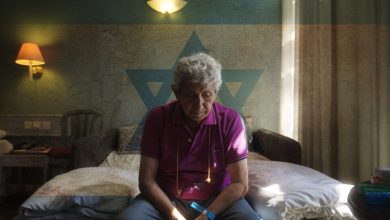We Must Learn to Look at Grief, Even When We Want to Run Away

Months ago, over Zoom, I told a patient’s wife that her husband was dying of Covid-19. She’d last seen him six weeks earlier when he first entered the hospital, but visitor restrictions had prevented her from being at his bedside.
I am a palliative medicine physician, and I met with her every week on a screen to guide her through the fog of grief as she made medical decisions for her husband. Covid had destroyed his lungs; he would most likely need a ventilator to breathe for him for the rest of his life. She said nothing for a long while. Then she told me he wouldn’t want to suffer anymore.
In the I.C.U. the next day, she wasn’t allowed to be at his side, but was given permission to see him from the other side of his room’s sliding doors. She stared at him, her slight frame swallowed by a billowing yellow P.P.E. gown. She removed her latex gloves and pressed her palms against the glass.
A nurse pushed pain medicine through his vein. The respiratory therapist removed his breathing tube in one graceful arc. My patient’s wife pressed harder against the door and inched closer. Her husband took slow, shallow breaths for a few minutes, and then he was still. She dropped her head and folded forward like paper curling toward the fire that consumes it. The imprint of her palms remained on the glass door.
More than 930,000 Americans have died of Covid-19. Many survivors still suffer from breathlessness, mind fog and debilitating fatigue. Though everyone was ground down by the continuance of the pandemic, we seem stuck in confusing divisiveness. Some people hesitate to see their elderly parents even when everyone is vaccinated, boosted and masked. Others suggest that it’s time to move on and find a new normal.We don’t have to be so divided. My work in palliative medicine offers a way to grapple with what has happened and to return more fully, together, to a world made smaller by who and what we have lost.
It’s natural and perhaps instinctive to want to look away from mortality, to deny its existence or banish it to a shadow world. But before us is an opportunity to examine, rather than bury, the loss and grief around us, even if — especially if — it is not our own.
Bearing witness is essential to everything I do in palliative care, be it treating a person’s cancer pain or discussing what matters most to them in their lives.I try to make visible to my patients and colleagues what is hard but necessary to see. Witnessing requires seeing another’s pain as no different from our own. This approach is a powerful way to move through the pandemic together.
In the throes of loss, people reach for certainty and control. My patient’s wife asked me what percentage of people as sick as her husband had survived and whether a risky therapy could promise life. I couldn’t offer her easy answers, only a willingness to stay and listen. Together, we wrestled with the burn of uncertainty. She shared photos of her husband over Zoom. They had sailed and cooked and taken selfies on the beach. Her photos said what words couldn’t. This is the person I have lost.
Earlier in my career, looking closely at this particular kind of pain was as blinding as looking at the sun. I distracted myself afterward with “S.N.L.” marathons and slabs of chocolate cake. Eventually, I realized that it wasn’t my job to protect people from their grief or to solve it.
I have learned to look when I want to look away. I have chosen to stay when I’d prefer to run out of the room and cry. The prelude to compassion is the willingness to see.
The memory of palm prints on that glass door cut through numbers and statistics and allowed me to process the human scale of suffering that had overwhelmed me throughout the pandemic. I thought about all the images of the past two years anew: body bags outside New York hospitals. Nurses using trash bags to protect themselves. Delhi’s skies darkened from mass cremations. Lists of my patients who died of Covid, most of whom were immigrants and people of color. The face of a teenager who stopped me outside my hospital and begged me to sit with her father because she wasn’t allowed inside.
This magnitude of suffering shook our world.Acknowledging it doesn’t require survivor’s guilt or forever dwelling on the past. We must allow ourselves to be moved by what happened and to understand that it happened, in different ways, to all of us.
One week before her husband died, my patient’s wife called to ask me how she could possibly move on with her life in a world where her husband didn’t exist anymore. I don’t believe in “moving on” and “finding closure.” This language distills the messy complexity of grief into tidy sound bites and asks people to leave something behind, bury it or lock it away. The challenge for my patients and their families is the challenge for all of us: Can we instead move forward with grief? Can we find a way to integrate loss into life, to carry it with us? Can we feel tragedy together, without an artificial line between those who are ready to move on and those who can’t see a way out?
We cannot simply be those who grieve and those who look away. To help one another, each of us must reach out, express condolences, write cards and offer to listen. Memorials can remind us that grief has affected people we see at the library or coffee shop. Sometimes we must endure the discomfort of seeing the pain of others without being able to intervene.
At different points over the past two years, so many of us pressed our palms against a glass door. We have pushed against what unfolded in front of us or tried desperately to grasp for what was six feet away, just out of reach. Covid may remain a pandemic for some time, or it may become endemic. But a change in nomenclature doesn’t mean we should forget the funeral pyres that burned like orange flowers, and it won’t change the fact that I didn’t make it to that teenager’s father before he died alone.
Our country can be united by seeing this suffering. We are all my patient and we are all his wife. Our collective grief, varied as our reactions to it may be, can bind us together when it seems like nothing else will. It is one lens through which we can recognize our shared humanity. None of this prevents life from moving forward, but it’s our best shot at bringing everybody along.
Dr. Sunita Puri (@SunitaPuriMD) is the author of “That Good Night: Life and Medicine in the Eleventh Hour.” She is an associate professor of medicine at the University of Southern California, where she has served as medical director of palliative medicine and chair of the ethics committee.
The Times is committed to publishing a diversity of letters to the editor. We’d like to hear what you think about this or any of our articles. Here are some tips. And here’s our email: [email protected].
Follow The New York Times Opinion section on Facebook, Twitter (@NYTopinion) and Instagram.





